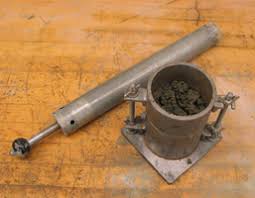Concept
The Proctor compaction test consists of compacting soil samples at a given water content in a standard mould with standard compaction energy. The standard Proctor test uses a 4-inch-diameter mould with the compaction of three separate layers of soil using 25 blows by a 5.5 lb hammer falling 12 inches.
In the Proctor test, the soil is first air dried and and then separated into 4 to 6 samples. The water content of each sample is adjusted by adding water (3% - 5% increments or more depending on the type of the soil).
The soil is then placed and compacted in the Proctor compaction mould in three different layers where each layer receives 25 blows of the standard hamer. Before placing each new layer, the surface of the previous layers is scratched in order to ensure a uniform distribution of the compaction effects.
At the end of the test, after removing and drying of the sample, the dry density and the water content of the sample is determined for each Proctor compaction test. Based on the whole set of results, a curve is plotted for the dry unit weight (or density) as a function of the water content. From this curve, the optimum water content to reach the maximum dry density can be obtained.


Standards
- ASTM D698 - 12 Standard Test Methods for Laboratory Compaction Characteristics of Soil Using Standard Effort (12 400 ft-lbf/ft3 (600 kN-m/m3)) Link
- ASTM D1557 - 12 Standard Test Methods for Laboratory Compaction Characteristics of Soil Using Modified Effort (56,000 ft-lbf/ft3 (2,700 kN-m/m3)) Link
References - External Links
NA
